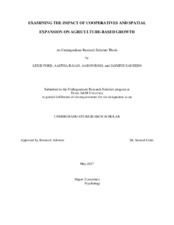| dc.creator | Ford, Lexie | |
| dc.creator | Rajan, Aastha | |
| dc.creator | Ross, Aaron | |
| dc.creator | Sausedo, Jasmine Cha | |
| dc.date.accessioned | 2017-10-10T20:28:24Z | |
| dc.date.available | 2017-10-10T20:28:24Z | |
| dc.date.created | 2019-05 | |
| dc.date.issued | 2016-08-30 | |
| dc.date.submitted | May 2019 | |
| dc.identifier.uri | https://hdl.handle.net/1969.1/164483 | |
| dc.description.abstract | The prosperous nations of today have a history of economic growth based on flourishing agricultural activity. This project aims to investigate causes of agricultural-based growth in the United States of America and Canada by drawing a comparison to Denmark. We compare the Danish dairy model with the dairy and wheat agriculture in the U.S. and Canada. We focus on Senghaas’ theory of social capital development by cooperative organization and Harvey’s theory of spatial fix by geographic expansion as possible explanations for agricultural productivity growth in the U.S., Canada, and Denmark. A qualitative analysis of agricultural histories provides weak evidence for successful cooperative movement in the U.S. and Canada as compared to the successful Danish model. The productivity comparison among the nations provides conclusive evidence for highest productivity in favor of the successful Scandinavian case while demonstrating productivity growth in all cases. However, historical agricultural production statistics do show evidence of massive volume of production in other cases despite low productivity. We further expand our analysis to understand the differences in Danish and North American experience based on the existence of frontier in the latter case. The results of correlation between productivity growth and input expansion also fail to explain the observed difference in productivity growth amongst the three cases. Thus, we conclude that neither cooperative organization nor availability of widespread arable land were causes of increasing agricultural productivity in the U.S. and Canada. Their impressive agricultural growth can likely be attributed to their massive scale of production made possible due to widespread arable land. | en |
| dc.format.mimetype | application/pdf | |
| dc.subject | agriculture | en |
| dc.subject | economic growth | en |
| dc.subject | productivity | en |
| dc.subject | dairy | en |
| dc.subject | wheat | en |
| dc.subject | Denmark | en |
| dc.subject | Canada | en |
| dc.subject | United States | en |
| dc.subject | economics | en |
| dc.subject | sociology | en |
| dc.subject | cooperative | en |
| dc.title | Examining the Impact of Cooperatives and Spatial Expansion on Agriculture-based Growth | en |
| dc.type | Thesis | en |
| thesis.degree.department | Psychology | en |
| thesis.degree.discipline | Psychology | en |
| thesis.degree.grantor | Undergraduate Research Scholars Program | en |
| thesis.degree.name | BS | en |
| thesis.degree.level | Undergraduate | en |
| dc.contributor.committeeMember | Cohn, Samuel | |
| dc.type.material | text | en |
| dc.date.updated | 2017-10-10T20:28:24Z | |


